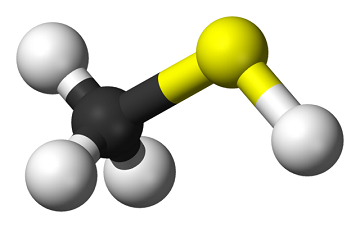Mercaptan

Mercaptan, also known as methanethiol is a foul-smelling gas that is added to natural gas - which is colourless and odourless - as an odorant to make it easier to detect.[2] Mercaptan is added as a safety measure to ensure that natural gas leaks do not go undetected. It is an organic gas composed of carbon, hydrogen, and sulfur. Mercaptan is found naturally in living organisms, including the human body where it is a waste product of metabolism.
Mercaptans bond strongly with mercury compounds, and most have strong odours resembling that of garlic or rotting cabbage.[3] These compounds are detectable by the human nose at concentrations as small as only 10 parts per billion, making them valuable as an odourant.[2] Natural gas distributors began adding these mercaptans to natural gas after a deadly school explosion in 1937 at the New London School in New London, Texas. Currently, most gas odorants are mixtures of mercaptans and sulfides.[3]
Although many mercaptans have foul odours, there are exceptions. For example, "grapefruit mercaptan" is responsible for the characteristic scent of grapefruit.[3]
References
- ↑ Wikimedia Commons. (June 15, 2015). Methanethiol [Online]. Available: http://commons.wikimedia.org/wiki/File:Methanethiol-3D-balls.png#/media/File:Methanethiol-3D-balls.png
- ↑ 2.0 2.1 Columbia Gas. (June 15, 2015). What is Mercaptan [Online]. Available: https://www.columbiagasohio.com/stay-safe/what-to-do-when-you-smell-gas/what-is-mercaptan-
- ↑ 3.0 3.1 3.2 Maria Mergel. (June 15, 2015). Mercaptans [Online]. Available: http://www.toxipedia.org/display/toxipedia/Mercaptans

